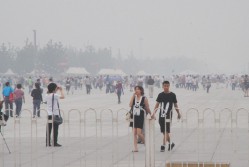
It’s no secret: I flipping love Beijing. Its perpetual smog, grimy streets and the iron fist of the communist party are not enough to shake my affection for the Chinese capital, the “northern” capital of ancient China that has been the center of the Middle Kingdom’s government five times throughout its history.
If there’s one thing I hope these photos illustrate to you, it’s that what Beijing lacks in traditional beauty, it compensates for ten-fold in character.

Beijing’s most alluring feature is the fact that it’s home to so many structures from the ancient Chinese period, as oppose to newer cities like Shanghai which are, well, new. Perhaps the most famous among these is the Forbidden City, pictured above, which dates back to the 15th century, when the Ming dynasty ruled over China.

A counterpoint to the ancient influence in Beijing is how often ancient structures are juxtaposed with modern one. Take the example of Tian’anmen Square, shown above, which sits just opposite the entrance to the Forbidden City, a palace that stands to honor the great legacy of ancient Chinese civilization, one the Maoists who built Tian’anmen sought largely to destroy.

As you can also see in both of the pictures that came before this one, smog in Beijing is indeed a big problem. It sometimes almost appears to be a white smoke, as seen in this picture of the Beijing Olympic grounds, which are still a popular tourist destination among Chinese people. Note also the extent of crowding in China.

Of course for every overcrowded, smog-filled, ugly place in Beijing, there is an equally beautiful, serene one. OK, maybe it isn’t one-to-one. One-to-ten? Twenty? In any case, the walkway leading up to the Lama Temple, as seen above, is a great example of the kind of natural splendor I’m talking about.

Ah, Beijing traffic. You knew it was coming, didn’t you? Although I’d imagine it’s a bitch to be sitting in one of these cars, there was something almost poetic about watching them sit there (for they weren’t moving) from a pedestrian overpass. In Beijing as well as in life in general, there are beautiful moments in even the most unfortunate realities.

Another juxtaposition! Beijing is chock full of these. Above you see the Summer Palace, which has its origins during the reign of Wanyan Liang in the Jin Dynasty period around 1120 AD. More recently the palace served as the summer (shock!) home of the Empress dowager Cixi in the late 19th and early 20th centuries.

Although Beijing has gained an international reputation as the nucleus of the oppressive Chinese government, this preconceived notion makes the appearance of the country’s exploding middle class seem all the more dramatic of streets on Beijing. From jiu bas (bars), to expensive electronics to designer handbags, hundreds of millions of Chinese people are now able to enjoy a standard of living comparable to those of us in the West. The Chinese middle class is estimated, in total, to number more than the population of the entire United States.

Some thing in Beijing are just plain bizarre. Take these psychedelic-looking mushrooms, for example, which emit a (presumably) water vapor mist into the air to cool passers-by during Beijing’s humid summers. Although their appearance likely owes more to their being built in the groovy 1960s than anything “magic,” the add yet another of character to the incredible Chinese capital.

Robert Schrader is a travel writer and photographer who’s been roaming the world independently since 2005, writing for publications such as “CNNGo” and “Shanghaiist” along the way. His blog, Leave Your Daily Hell, provides a mix of travel advice, destination guides and personal essays covering the more esoteric aspects of life as a traveler.








